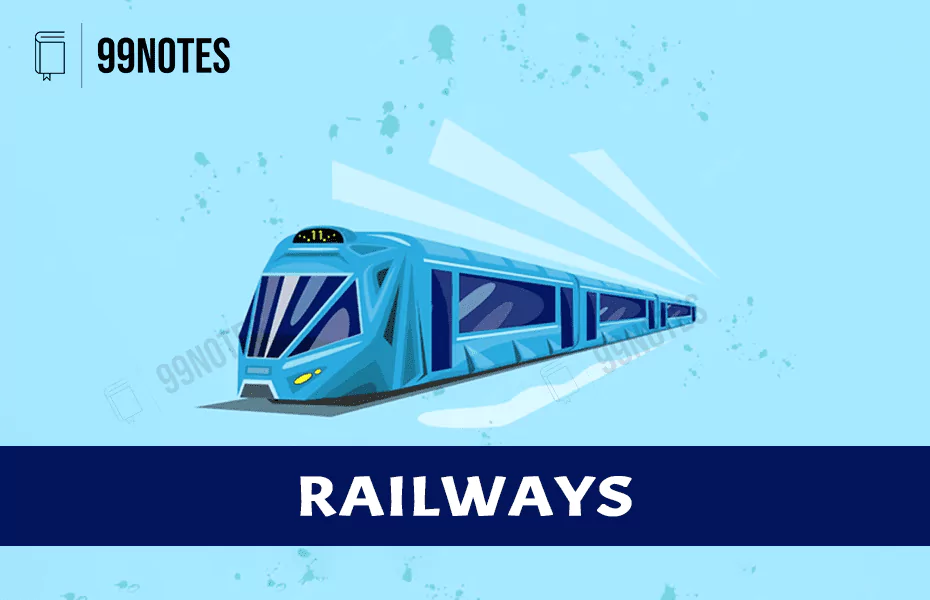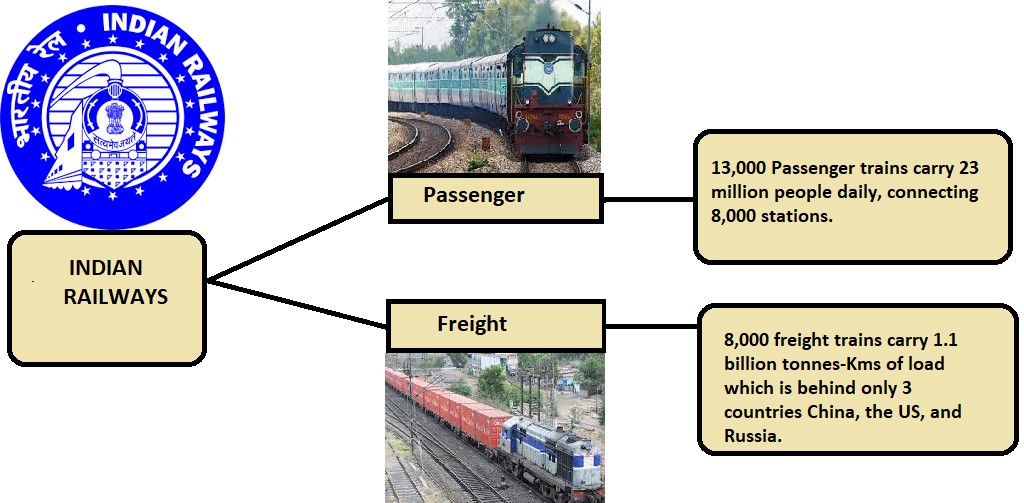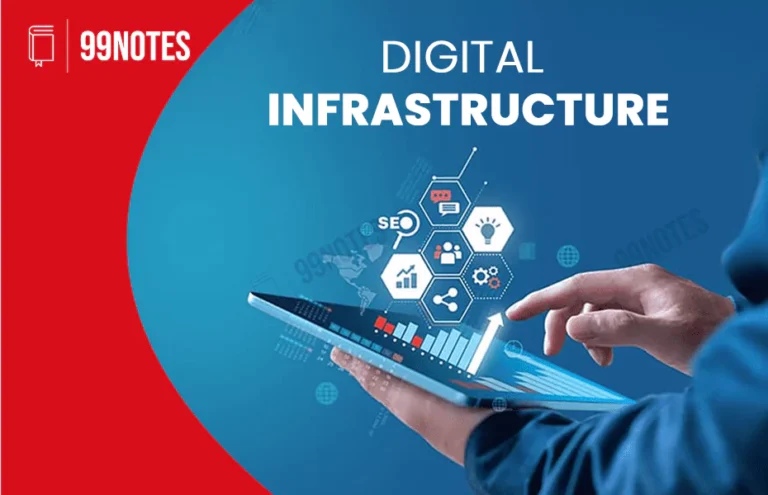Indian Railways: Complete Indian Economy Notes for UPSC
Indian Railways
‘Indian Railways’ is the country’s most significant public sector undertaking, comprising vast network stations and route length with a fleet of locomotives, passenger vehicles, etc. It operates the world’s fourth-longest rail network.
Issues associated with the Railway sector: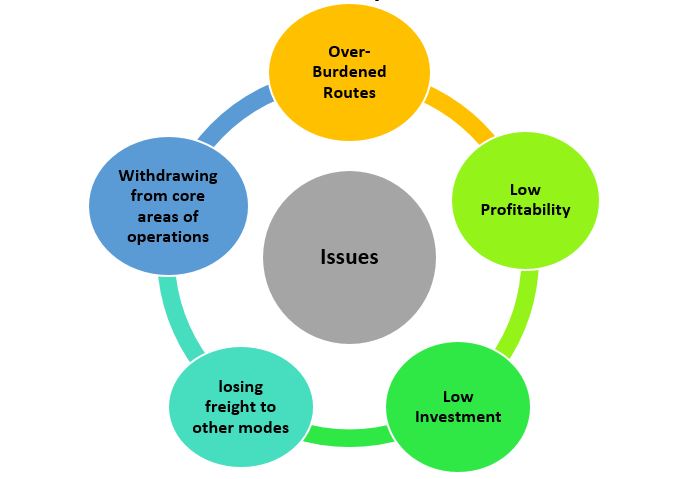
- Over-burdened routes: Overburdened routes Lead to delays and revenue losses. Ex: Howrah-Delhi is running at 150% of its capacity & Delhi-Mumbai at 115%.
- Low Profitability: Indian Railway charges lowest fares in the world due to it being highly subsidised by the government of India. Non-AC fares had remained static for 12 years before 2018, but the fare marginally increased recently (2019-2020).
- Treating railways as a Cash-cow: Though it pays the government a 6.25% dividend yearly, it attracts very few investors.
- Withdrawing from core areas: Withdrawing from core areas of operations and concentrating on peripheral items.
- Ex: They’ve withdrawn themselves from all urban transport activities.
- In the 1990s, it would have benefitted if it had devised innovative solutions like forming SPVs to catalyse the construction of metro lines.
- Railway losing freight to other modes: The compound annual growth rate(CAGR) was 2-5% between 2014-18; during the same period CAGR for transport was about 6.5%, and power generation growth was 5.5%.
- Concerns:
-
-
- Non-competitive tariff structure.
- Fierce competition from other modes of transport: After the Golden quadrilateral and expressways, road transport has become convenient.
-
-
-
-
- Artificially jacked up freight rates – lost business to road hauliers.
- Petroleum transport businesses were lost to pipelines(75% to 10%).
- The rail share in the freight is down from 89% in 1950-51 to less than 30% in 2014-15.
-
-
- Inefficiency: Red-tapism & lack of competitiveness reduces efficiency.
- Lack of proper Multiple mode transits: Lack of appropriate logistic support from one mode to other.
- The decline of PSUs: PSUs like Coal India transported most of their coal by railway and was the Indian Railway’s largest client in the fall.
Growth of Railway freight in the last couple of years:
- Less Traffic: Due to the pandemic, passenger traffic has taken a hit, leaving room for freight traffic to expand.
- Dedicated freight corridor(DFCs): Opening the important segments of the Dadri-Khurja-Kanpur, Kanpur-Mughal-Sarai stretches of the eastern DFC and the Western DFC Khurja to JNPT.
- Increasing investment: Signalling, stations, inland ports and logistics investments have increased in the network recently.
- Increased speed: This increased the speed of the traffic.
- Inviting the private sector : The government is encouraging Private investments in the development and operation of railways. Ex: The operation of trains, Railway yards etc.
- Improvement in Tariff structure: The government has tried to maintain the freight tariff in recent years, not allowing it to inflate.
- Sectors-specific interventions: Catering to specific needs of the Industry. Ex: the Kisan Rail service for transporting perishable goods has seen a 15% increase in traffic.
Long-term Aim of Indian Railways:
For long-term benefit Committee on Rail modernisation recommended ₹ 5,60,000 Cr from 2015 to 2020.
- Tracks & Bridges:
- Rails designed speed of 75/100kmph for freight trains; 160/200kmph for Passenger trains.
- Robust fencing in urban/semi-urban areas and light fencing in rural areas.
- High-speed passenger train corridor: Ex: Mumbai-Ahemdabad 350Kmph.
- Dedicated freight corridors(DFCs): A target of completing 6,200kms in 10yrs in the N-S + E-W + East coast + southern region. Upgradation of feeder routes 6,000Kms suitable for 25Tonne axle load.
- Signalling: Efficient signal management will boost the train management system effectively.
- Rolling Stock:
- New generation electric locomotives (9k & 12k HP) and high HP(5.5HP) diesel locomotives.
- Traction development for fuel efficiency.
- High-speed coach for 160/200 kmph.
- Terminal Development:
- Stations/terminals: 100 major stations among 770 will modernise immediately.
- 100 Freight terminals will be developed on a priority basis.
- ₹50,000 cr was allocated to Monetize Land and airspace.
Corridors announced by Indian Railways:
- Diamond Quadrilateral: Six corridors on Diamond Quadrilateral connecting 4 metropolitan cities (Delhi, Mumbai, Chennai & Kolkata) have been identified for feasibility studies for high-speed rail connectivity.

- Semi-high speed trains(200kmph) on nine corridors. They are:
- Delhi-Agra,
- Delhi-Chandigarh,
- Delhi-Kanpur,
- Mysore-Bangalore-Chennai,
- Chennai Hyderabad,
- Secunderabad-Nagpur,
- Nagpur-Bilaspur,
- Mumbai-Goa,
- Mumbai-Ahemdabad.
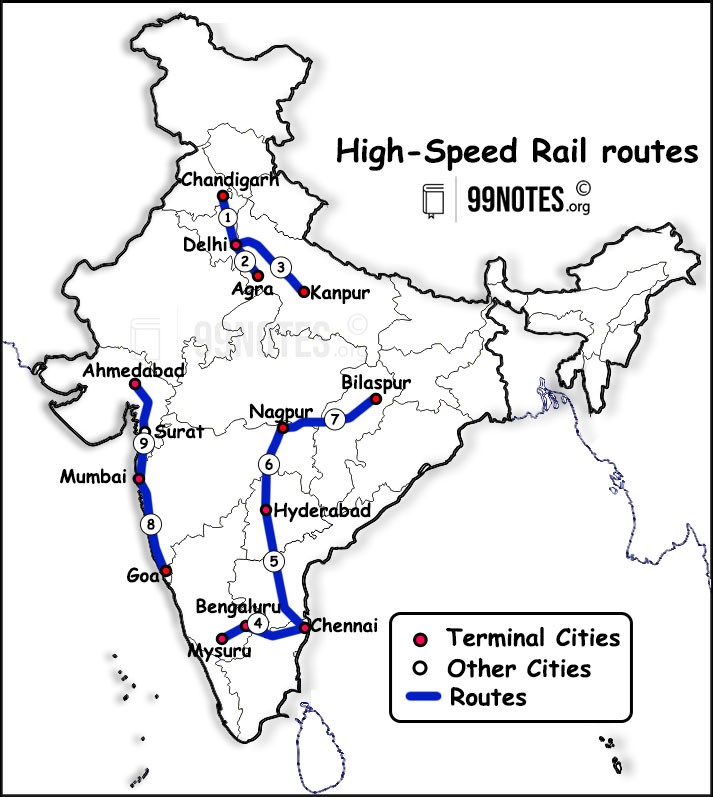
- Vande Bharat: 102 Vande Bharat trains to be operational by 2024.
- High-speed train(350kmph) on the Mumbai-Ahmedabad section will be the first bullet train corridor to be implemented in the country. According to the Railway’s “Vision document 2020” several other corridors are proposed.
- Dedicated Freight Corridor(DFC) project:
-
- This corridor aims to bring down logistics costs.
- The project will be implemented by the Dedicated Freight Corridor Corporation of India(DFCCIL) with the assistance of the World Bank.
- The main components of this project are:
- Eastern DFC: Ludhiana–Khurja–Dankuni(Kolkata).
- Western DFC: Khurja to JNPT(Mumbai) – It runs along the DMIC(Delhi Mumbai Industrial Corridor), connecting Rewari-Phulera-Marwar-Palanpur-Sabarmati-Vadodara.
- Future dedicated freight corridor projects –
- East Coast corridor from Kharagpur to Vijayawada.
- East-West Corridor from Bhusaval to Kharagpur to Dankuni.
- North-South corridor from Itarsi to Vijayawada.
National Rail Plan for India (2030):
Indian Railways has developed a National Rail Plan to prepare a ‘future-ready’ Railway by 2030. This policy aims to formulate strategies based on operational capacities and commercial policy initiatives to raise the modal share of the Railways in freight to 45%.
Some Important aspects of the Rail Plan are:
- Introduction of Private Trains in India: Private Trains will operate from March 2023. The demarcation of the responsibility has been done carefully.
-
- Employees of the Railway: The railway crew will work the trains, which the private investor will maintain.
- Responsibility of private investor: investment in the procurement and maintenance of coaches.
- Responsibility of Railways:
- The Railways will own all the other infrastructure (track and associated structures, stations, signalling, security and daily maintenance).
- Train operation, safety and dealing with everyday problems rest with the Railways.
- Problem: Fixing the responsibility of day-to-day is still unclear, and so on.
- Network expansion: The main component of network expansion is port connectivity with the Mineral exploration site with the Joint venture of Coal India, Steel companies and concerned states.
- Doubling 18000km tracks.
- Conversion of tracks into broad gauge.
- Electrification of Tracks: About 58% of the route is electrified. 100% electrificationof Broad-Gauge routes to be completed by December 2023.
- Rolling stock:
- 7000 new locomotives & More coaches were allotted to each train.
- Train 18: India’s first engine-less long-distance train(EMU: Electrical multiple units) breached the 180kmph speed threshold.
- It has a potential speed of 200kmph(Semi-high speed).
- 1st train: New Delhi to Varanasi.
- Passenger service:
-
- Free wifi service at selected stations and trains with the assistance of Google.
- Upgradation of coaches in all categories.
-
- Passenger convenience and safety:
- Vista Dome LHB coaches were introduced on tourist routes for a better travel experience.
- Track renewals: 4500 km is required to be renewed annually.
- Indigenously developed automatic train protection system.
- Elimination of Level crossings etc.
- Security:
- CCTV cameras have been installed in selected trains and stations (around 1000)with Nirbhaya Fund.
- Railway Protection Force (RPF) Security helpline 182 was installed for the assistance of Passengers.
- Networking of Posts and Security Control Rooms of the RPF.
- Government Railway Police(GRP) & RPF jawans escorting 4,700 mail/express trains.
- Human Errors: To avoid human errors, the following measures have been taken
- Train Protection Warning Systems (TPWS).
- Anti-collision device (ACD).
- “Terrain imaging for diesel drivers, infrared enhanced optical and radar assisted system“( Tri-Netra): It provides a locomotive pilot with a clear view of up to 1 kilometre on a straight track, even during inclement weather. It is made up of 3 components:
- High-resolution optical video camera.
- High-sensitivity infrared video camera.
- Radar-based terrain mapping system.
- Computerised Signalling:
- Integrated coaching management system(ICMS): IT-enabled online monitoring of trains.
- Fully computerised signalling by 2022.
- Increasing Profits with dynamic pricing:
- A flexi-fare system in premier trains like Shatabdi, Rajdhani, and Duranto was introduced.
- Green Train corridors:
- Bio-Toilet Tanks have been developed by the Indian railway(IR) and DRDO.
- Railway stations:
- Indian Railway station Development Corporation(IRSDC) would modernise more than 600 railway stations in 3 phases. Increasing Profits with dynamic pricing:
Budget 2023-24
Rs 2.40 lakh crore has been allocated for the Indian Railways, 9 times more than in 2013-14.
Important Organisations and their purposes:
1. Rail Development Authority:
- Encouraging market upliftment and participation of stakeholders in the rail sector.
- Benchmarking of service standards against international norms and specifying and enforcing them.
- Providing a framework for non-discriminatory open access to the DFCs.
2. Rail India Technology and Economic Services(RITES):
- It is a PSE and export arm of the railways.
- It supplies rolling stock (locomotives, coaches, wagons), maintenance of railway infrastructure, technical studies, and training of Myanmar Railway officials.
Ex: 18 microprocessor-controlled Indian locomotives to Myanmar Railways, diesel locos were given to Sri Lanka & Bangladesh.
- Export Data-
- India was in the top 20 exporters of railways globally as of 2017.
- India’s export of railways has grown at a CAGR above 30% during 2010-2020.
- Exports of railways in 2019 stood at US$ 635 million.
Conclusion
We can observe that the Indian Railway network is thriving at a healthy rate. In the next five years, the Indian railway market will be the 3 rd largest, accounting for 10% of the global market.
The essential need is to find a balanced approach. Recommendations given by the Bibek Debroy committee can be a suitable way forward in this way.

